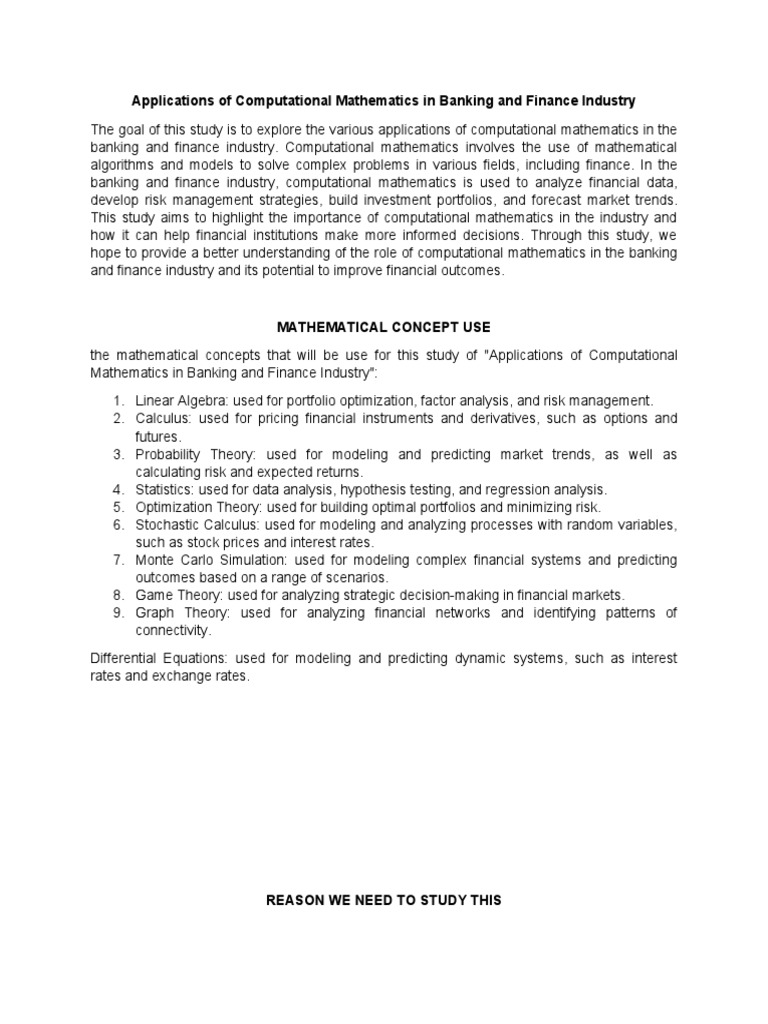Computational mathematics serves as the cornerstone of modern scientific exploration, akin to a compass guiding mariners through the tempestuous seas of complex problems. It is a discipline that melds mathematical theory with computational prowess, offering tools that are indispensable in various sectors. When wading into the ocean of its applications, one discovers a veritable treasure trove that impacts numerous fields—from engineering to finance, from climate modeling to healthcare.
First and foremost, in the realm of engineering, computational mathematics facilitates design and optimization processes that are critical for innovation. Engineers leverage numerical methods to solve differential equations that govern physical processes. Finite element analysis (FEA) exemplifies this principle, allowing for the simulation of stress and strain in materials under varying conditions. As architects design skyscrapers that touch the clouds, computational mathematics serves as the latent force ensuring structural integrity, enabling us to push the boundaries of design, heritage, and technology.
In the field of finance, applications of computational mathematics resonate profoundly. The financial sector employs various mathematical models to forecast market trends and to evaluate risks. Techniques such as Monte Carlo simulations pave the way for analyzing the probability of different outcomes in investment portfolios. Just as a sailor uses the stars to navigate, financial analysts rely on intricate algorithms to chart a course through volatile markets. Derivatives pricing, asset valuation, and risk management are all grounded in mathematical theories that highlight the synergy of computational techniques and economic principles.
The realm of data science represents another fertile ground for computational mathematics. In an epoch defined by information explosion, the ability to distill actionable insights from colossal datasets is paramount. Algorithms that underpin machine learning and artificial intelligence are steeped in advanced mathematical concepts. Neural networks, for example, mimic the human brain’s architecture and leverage vast networks of input data to discern patterns. The predictive capabilities derived from these models have applications as diverse as self-driving vehicles and personalized medicine, showcasing the transformative impact of computational mathematics in day-to-day life.
Furthermore, computational mathematics plays a pivotal role in environmental science. As climate change looms, the need for predictive models has never been more pressing. Numerical simulations help scientists understand complex systems, from ocean currents to atmospheric dynamics. To foresee the variables that contribute to climate phenomena, researchers rely on sophisticated mathematical models that process vast quantities of data. The predictive simulations yield insights that guide policymakers in crafting strategies to mitigate environmental impacts, illustrating how mathematics can align with sustainability.
The healthcare sector also derives immense benefits from computational mathematics. In medical imaging, techniques such as computed tomography (CT) and magnetic resonance imaging (MRI) rely on algorithms that reconstruct images from raw data through intricate mathematical transformations. By enhancing diagnostic accuracy, these technologies deliver life-saving interventions. Furthermore, computational mathematics aids in drug discovery; various algorithms sift through massive databases of molecular structures to identify potential candidates for pharmaceutical development—a meticulous but necessary endeavor that speeds up the process of bringing new healthcare solutions to market.
Moreover, computational mathematics is indispensable in operations research and logistics, where optimization techniques streamline processes from supply chain management to transportation networks. By employing linear programming and integer programming, businesses can minimize costs and maximize efficiency, ensuring the seamless movement of goods and services. Like modern-day alchemists, operations researchers transmogrify complex data into strategic insights that can revolutionize industries.
Another area worth noting is computational physics, which has historically played a crucial role in expanding our understanding of the universe. Simulations of particle physics, astrophysics, and even quantum mechanics rely heavily on numerical approaches. The Large Hadron Collider, for example, produces data so vast and complex that computational mathematics becomes the key to unlocking the secrets of fundamental particles, thereby advancing our grasp of the cosmos.
Educational institutions have also recognized the importance of computational mathematics, embedding the subject within various curricula. As future generations of scientists, engineers, and economists embark on their academic journeys, the synthesis of mathematics and computation underscores the interdisciplinary nature of modern education. Institutions foster environments where computational techniques become tools for innovation, shaping the next cohort of thinkers and problem-solvers.
In conclusion, the multifaceted applications of computational mathematics form an intricate web that is woven into the fabric of numerous disciplines. From the precise calculations that ensure the safety of our buildings and bridges to the quantitative analyses that drive financial strategies, its influence is pervasive and profound. It stands not merely as an academic abstraction but as a vital component of contemporary life, essential for navigating challenges and harnessing opportunities across a myriad of sectors. As we continue to embrace the potential of computational mathematics, we unlock the doors to a future sculpted by informed decisions and innovative solutions.












